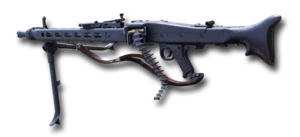
Back راينميتال أم جي 3 Arabic Rheinmetall MG3 Azerbaijani MG3 Corsican MG3 Czech MG3 Danish MG3 German Rheinmetall MG3 Spanish MG3 Estonian امگه۳ Persian MG3 Finnish
| MG 3 | |
|---|---|
 A MG 3 | |
| Type | General-purpose machine gun |
| Place of origin | West Germany |
| Service history | |
| In service | 1959–present |
| Used by | See Users |
| Wars | Nigerian Civil War Bangladesh Liberation War[1] Iran–Iraq War Lebanese Civil War The Troubles Kurdish–Turkish conflict Second Sudanese Civil War[2] Somali Civil War Kargil War War in Afghanistan War in North-West Pakistan Syrian Civil War Boko Haram insurgency[3] Libyan Civil War War in Iraq (2013–2017)[4] Yemeni Civil War (2015–present)[5] Russo-Ukrainian War[6] Myanmar Civil War |
| Production history | |
| Designed | 1959 |
| Manufacturer | Rheinmetall License-built by: Beretta, MKEK, Ellinika Amyntika Systimata, Defense Industries Organization, Military Industry Corporation, Pakistan Ordnance Factories, General Dynamics Santa Bárbara Sistemas |
| Produced | 1959–present |
| No. built | 1 million+ |
| Variants | See Variants |
| Specifications | |
| Mass | 11.5 kg (25.35 lb)[7] 27.5 kg (61 lb) (mounted on tripod) |
| Length | 1,225 mm (48.2 in) 1,097 mm (43.2 in) (without stock) |
| Barrel length | 565 mm (22.2 in) |
| Cartridge | 7.62×51mm NATO |
| Action | Recoil-operated, roller locked |
| Rate of fire | 800–950 rounds/min or 1,000–1,200 rounds/min |
| Muzzle velocity | 820 m/s (2,690 ft/s) |
| Effective firing range | 200–1,200 m sight adjustments |
| Maximum firing range | 600 m (1,969 ft) (bipod) 1,200–1,600 m (3,937–5,249 ft) (tripod mounted) 3,000 m (9,843 ft) (gun carriage) 3,750 m (12,303 ft) (terminal) |
| Feed system | 50-round non-disintegrating DM1 belt (can be combined in a drum); 100-round disintegrating DM6/M13 belt |
| Sights | Open tangent iron sights or optical sights |
The MG 3 is a German general-purpose machine gun chambered for the 7.62×51mm NATO cartridge. The weapon's design is derived from the World War II era MG 42 that fired the 7.92×57mm Mauser round.[8]
The MG 3 was standardized in the late 1950s and adopted into service with the newly formed Bundeswehr, where it continues to serve to this day as a squad support weapon and a vehicle-mounted machine gun. The weapon and its derivatives have also been acquired by the armed forces of over 40 countries. Production rights to the machine gun were purchased by Italy (MG 42/59 [it]), Spain, Pakistan (MG 1A3), Greece, Iran, Sudan and Turkey.[9]
- ^ McNab, Chris (2002). 20th Century Military Uniforms (2nd ed.). Kent: Grange Books. p. 31. ISBN 1-84013-476-3.
- ^ "Sudan – Global trade, local impact: Arms Transfers to all Sides in the Civil War in Sudan" (PDF). Human Rights Watch Report. 10 (4): 25. August 1998.
- ^ Cite error: The named reference
Tessiereswas invoked but never defined (see the help page). - ^ VICE News (27 April 2016). "What It's Really Like to Fight for the Islamic State". YouTube. Archived from the original on 12 December 2021.
- ^ Dnevnik (in Slovenian). Ljubljana, Slovenia: Radiotelevizija Slovenija. 2015. Event occurs at 17:13. Retrieved 8 August 2015.
- ^ Nikolov, Boyko (28 March 2022). "1,500 Soviet Strela-2 MANPADS and 100 MG3 arrived in Ukraine". BulgarianMilitary.com.
- ^ Bundesministerium der Verteidigung (26 June 1979). "Dv 3-14 Das Maschinengewehr" (PDF) (in German) – via Wikimedia Commons.
- ^ Woźniak, Ryszard (2001). Encyklopedia najnowszej broni palnej—tom 3 M-P (in Polish). Warsaw: Bellona. p. 106.
- ^ "7.62 mm MG3 Machine Gun". MKEK. Archived from the original on 15 September 2009. Retrieved 4 April 2014.